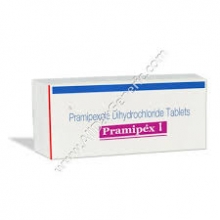Home / Categories / PRAMIPEX-1MG

PRAMIPEX-1MG
(10X5)
PRAMIPEXOLE DIHYDROCHLORIDE 1MG
ANTI-PARKINSONIAN DRUGS
SUN PHARMA LTD
Product Details
Pramipexole Dihydrochloride
A to Z Drug Facts
Pramipexole Dihydrochloride
Action
Indications
Contraindications
Route/Dosage
Interactions
Lab Test Interferences
Adverse Reactions
PrecautionsPatient Care Considerations
Administration/Storage
Assessment/Interventions
Patient/Family Education
(pram-ih-PEX-ole)MirapexClass: Antiparkinson/Non-ergot dopamine receptor agonist
 Action Stimulates dopamine receptors in the corpus striatum, relieving parkinsonian symptoms.
Action Stimulates dopamine receptors in the corpus striatum, relieving parkinsonian symptoms.
 Indications Treatment of the signs and symptoms of idiopathic Parkinson's disease. May be used in conjunction with L-dopa.
Indications Treatment of the signs and symptoms of idiopathic Parkinson's disease. May be used in conjunction with L-dopa.
 Contraindications Standard considerations.
Contraindications Standard considerations.
 Route/Dosage
Route/Dosage
Individualize by careful titration. ADULTS: PO Initial dose: 0.125 mg tid. Maintenance dose: Dosage may be increased every 5 to 7 days to maximum dose of 4.5 mg/day.
 Interactions
Interactions
Drugs eliminated via cationic renal secretion (eg, cimetidine, ranitidine, diltiazem, triamterene, verapamil, quinidine, quinine): May reduce oral clearance of pramipexole. Pramipexole dosage adjustment may be needed if therapy with any of these agents is started or stopped during treatment with pramipexole. Dopamine antagonists (eg, butyrophenones, metoclopramide, phenothiazines, thioxanthenes): May reduce effectiveness of pramipexole.
 Lab Test Interferences None well documented.
Lab Test Interferences None well documented.
 Adverse Reactions
Adverse Reactions
CV: Orthostatic hypotension. CNS: Dizziness; somnolence; headache; confusion; hallucinations; abnormal dreams; tremor; insomnia; aggravated Parkinson's disease; dyskinesia; hypokinesia; hypesthesia; amnesia; extrapyramidal syndrome; abnormal thinking; hypertonia; akathisia; dystonia; delusions; paranoid reactions. EENT: Abnormal vision; rhinitis. GI: Nausea; dyspepsia; constipation; dry mouth; anorexia; dysphagia. GU: Urinary tract infection; urinary frequency; urinary incontinence; impotence; decreased libido. RESP: Dyspnea; pneumonia. OTHER: Asthenia; edema; malaise; injury; fever; weight decrease; myoclonus.
 Precautions
Precautions
Pregnancy: Category C. Lactation: Inhibits prolactin secretion. Do not give to nursing mothers. Children: Safety and efficacy have not been established. Elderly: Incidence of hallucinations appears to be increased with age. Renal function impairment: Use with caution in presence of moderate-to-severe renal function impairment. Use lower initial and maintenance doses. Hypotension: Postural hypotension may occur, especially during dose escalation. Hallucinations: Can occur during pramipexole therapy. Frequency is greater when used in conjunction with L-dopa. Dyskinesia: Pramipexole may potentiate dopaminergic side effects of L-dopa and may cause or exacerbate pre-existing dyskinesias. Abrupt withdrawal: Rapid withdrawal or dose reduction of antiparkinsonism drugs may produce symptoms resembling the neuroleptic malignant syndrome. Retinal pathology: Pathological changes were observed in the retinas of albino rats receiving dopaminergic receptor agonists. The potential significance of this effect in humans has not been established but cannot be disregarded. CNS effects: Use concomitant CNS depressants with caution because of additive sedative effects. Concurrent L-dopa use: When pramipexole is used in combination with levodopa, the dose of levodopa may be reduced as tolerated.
PATIENT CARE CONSIDERATIONS
 Administration/Storage
Administration/Storage
- Administer tid without regard to food.
- If nausea occurs, administer each dose with food.
- Store at controlled room temperature protected from light.
 Assessment/Interventions
Assessment/Interventions
- Obtain patient history, including drug history and any known allergies.
- Note renal function impairment.
- Complete baseline assessment of parkinsonian symptoms before instituting therapy.
- Assess for therapeutic effects, adverse reactions, and drug interactions throughout course of therapy.
- Assess for orthostatic hypotension, dizziness, and mental status changes during initial phase of therapy or following dose escalation.
- Assist patient with position changes and ambulation during initial therapy to prevent falling.
- Monitor blood pressure and pulse routinely during therapy.
- Do not administer if significant changes in BP, pulse, or mental status occur. Notify physician.
 Patient/Family Education
Patient/Family Education
- Instruct patient to take exactly as prescribed. Advise patient that dose may be taken without regard to meals but to take with food if nausea occurs.
- Inform patient that drug may cause drowsiness and to use caution while driving or performing other tasks requiring mental alertness.
- Instruct patient to avoid sudden position changes to prevent orthostatic hypotension.
- Instruct patient to report the following symptoms to physician: Uncontrollable movements, dizziness, mood or mental changes, severe or persistent nausea, headache.
- Inform patient that hallucinations can occur and that elderly are more susceptible.
- Advise patient to use caution when taking other drugs with CNS depressant effects (eg, alcohol, sedatives).
- Advise patient not to take any other medications (including otc) without consulting physician.
- Advise patient to notify physician if becoming pregnant, planning to become pregnant, or are breastfeeding while taking this medication.
Books@Ovid
Copyright © 2003 Facts and Comparisons
David S. Tatro
A to Z Drug Facts
Substitutes
Substitutes not found for PRAMIPEX-1MG